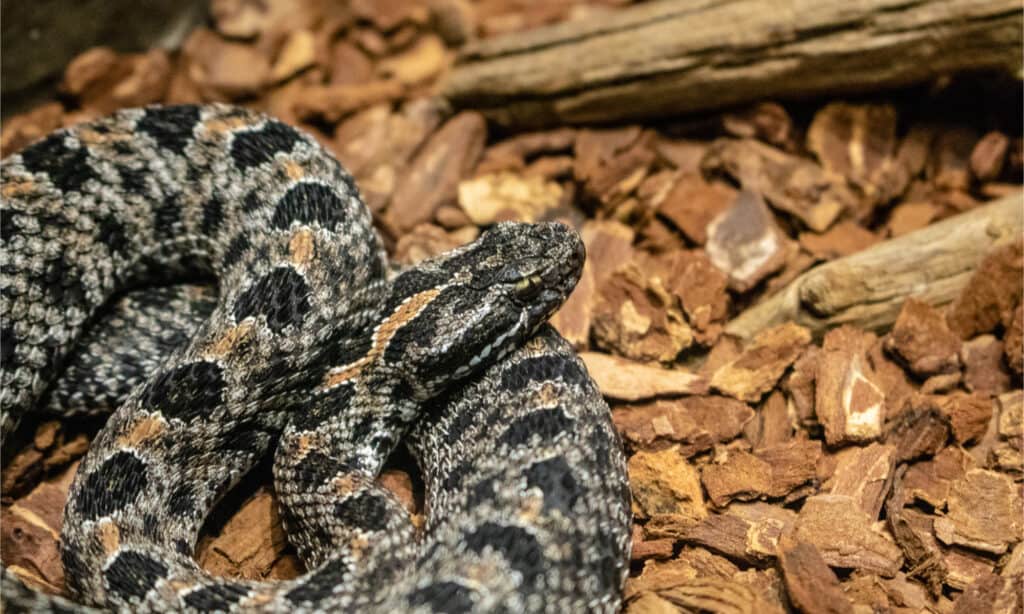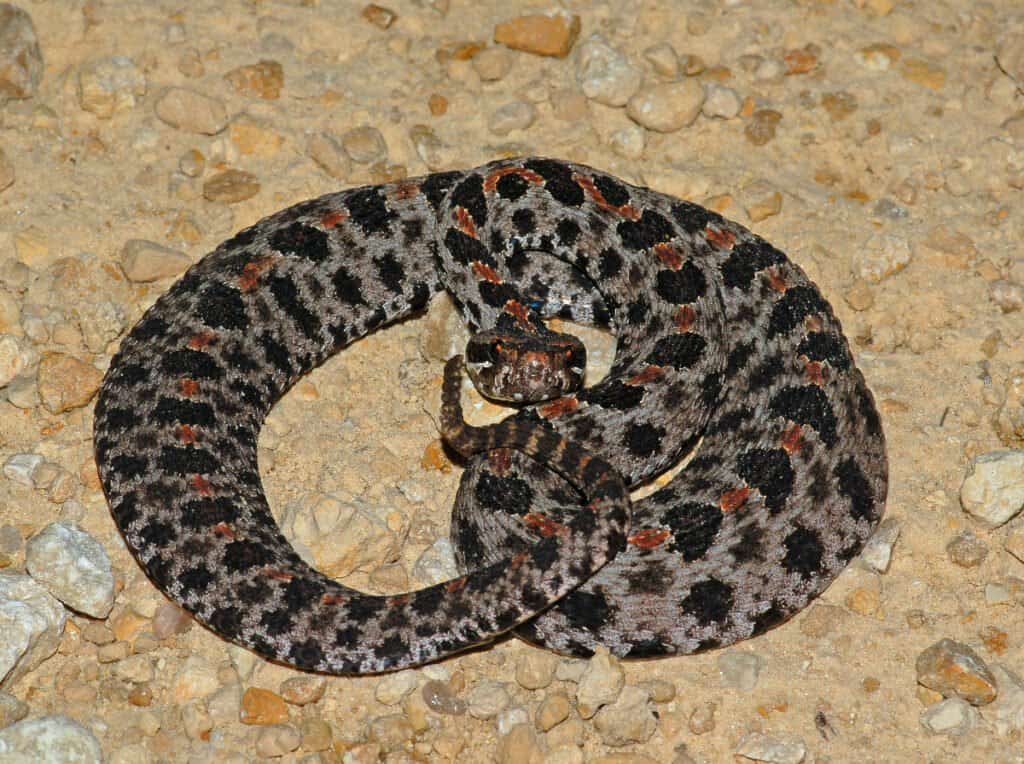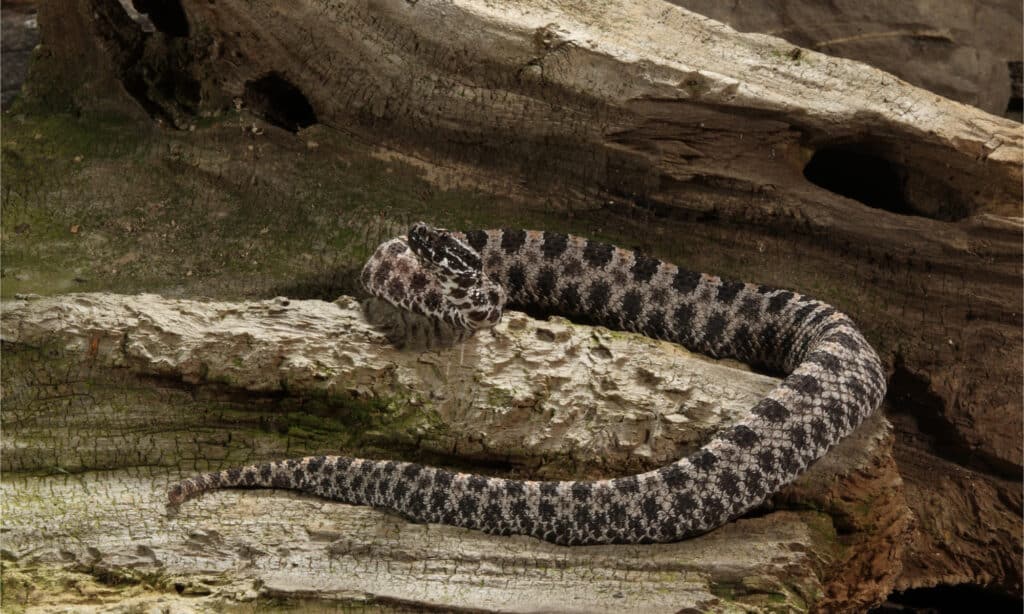True to their name, the pygmy rattlesnakes are the smallest species of rattlesnakes in the United States. A silent rattlesnake like no other, they are so small that people get bitten because they approach way too closely before anyone even notices them.
They’re one of the least known venomous snakes in the U.S., also referred to as eastern pygmy rattlesnakes, ground rattlesnakes, leaf rattlers, or ground rattlers. These tiny snakes spend most of their time well-hidden among leaf litter, from where they ambush a variety of smaller prey.
While the average size of a pygmy rattlesnake ranges from 12 to 24 inches, some larger species have been encountered on rare occasions. So, what is the largest pygmy rattlesnake ever found? Read on to find out!
Background on Pygmy Rattlesnakes

The Dusky pygmy rattlesnake is one of three subspecies of pygmy rattlesnakes.
©Suzanna Ruby/Shutterstock.com
The pygmy rattlesnake (scientific name Sistrurus miliarius) is a venomous snake species in the subfamily Crotalinae (pit vipers) of the family Viperidae, endemic to the Southeastern region of the United States. Three subspecies of pygmy rattlesnakes are currently recognized; Dusky pygmy rattlesnake (S. m. barbouri), Carolina pygmy rattlesnake (S. m. miliarius), and Western pygmy rattlesnake (S. m. streckeri).
Appearance
Unlike other rattlesnakes, pygmy rattlesnakes have tiny rattles and are extremely small. They are short but relatively thick-bodied. This species appears in different colors, varying from black, tan, grey, and brown to light red or pink. They usually have alternating red and black spots running down the back, interrupting a thin reddish-orange stripe that runs along the midbody. The spots on either side of the flanks are multiple round black blotches.
Pygmy rattlesnakes have prominent black lines on their head running from the eyes to the corners of the mouth on each side of their face – which gives them a cat-like appearance. They also possess front hinge fangs to catch and inject venom into their prey. Baby pygmy rattlesnakes are similar to adults in appearance, but the tips of their tails are yellow, becoming darker as they reach adulthood. Interestingly, they do not have rattles at all until maturity.
Behavior

While some pygmy rattlesnakes are very aggressive and strike furiously, others seem lazy and do not even attempt to rattle.
©Gerald A. DeBoer/Shutterstock.com
Pygmy rattlesnakes have a solitary nature, barely interacting with other animals or their own species. They typically spend their lives alone in abandoned mammal burrows or under logs. Pygmy rattlesnakes do not dig their own burrows, but they are known to live in those dug by small rodents or gopher tortoises. However, this small snake can sometimes be seen in the summer, basking in the sun or crossing roads at night. It has a tiny rattle that makes a slight buzzing sound that you can hear no farther than 3 feet away. While some individuals are very aggressive and strike furiously, others seem lazy and do not even attempt to rattle.
Range and Habitat
Pygmy rattlesnakes inhabit many habitats, including swamps, moist lowlands, sandhills, mixed forests, wet prairies, and floodplains. They are more likely to be encountered near bodies of water and places with vegetative coverage, such as temperate forests, lakes, and marshes. This rattlesnake species is native to the United States, especially in the Southeastern United States.
Their range varies according to subspecies. Dusky pygmy rattlesnakes are primarily found in southern South Carolina through southern Georgia, all of Florida, west through southern Alabama, and southeastern Mississippi. Carolina pygmy rattlesnakes’ range extends from southern South Carolina northwards into eastern North Carolina and west through central Georgia and Alabama, into the Eastern parts of the Mississippi. Western pygmy rattlesnakes are majorly found in Mississippi, Louisiana, and Alabama. Their range extends west through Louisiana into Eastern Texas and north into southeastern Oklahoma, Arkansas, southern Missouri, and southwestern Tennessee.
Diet

Pygmy rattlesnakes eat birds, lizards, insects, and frogs.
©Dennis W Donohue/Shutterstock.com
The diet of the pygmy rattlesnake includes small mammals (especially mice), birds, lizards, insects, frogs, and other snakes. They also eat giant desert centipedes, which they hunt by active pursuit, grabbing and flipping the centipedes around while simultaneously injecting venom into them with their hollow fangs. Pygmy rattlesnakes ambush prey using their tails as lures (a phenomenon known as caudal luring), as is common in many other species of vipers. But because of the large size of adult prey, their feeding strategy becomes sit-and-wait (also a form of ambush) which involves them remaining in a coiled position for days while waiting for the target to come to them. They detect prey using heat-sensitive areas called “facial pits” between their eyes and nostrils, allowing them to perceive the game’s location.
Lifespan
Pygmy rattlesnakes have an average lifespan of up to 16.1 years when in captivity. However, the lifespans of these snakes in the wild have not been reported.
Danger
Pygmy rattlesnakes, although a venomous species, are not very deadly. They produce a fairly toxic venom; cytotoxic, strongly hemorrhagic, and tissue-toxic (though it lacks neurotoxin). However, they deliver venom in very small amounts, so their bite is unlikely to be fatal to a human adult. They are docile creatures who often prefer to run away from a threat or predator rather than fight. But, if they feel extremely threatened or cornered, they will become aggressive and may try to defend themselves by striking. A bite from a pygmy rattlesnake is potentially harmful and requires immediate medical attention. Victims often show symptoms of pain, swelling, blisters, discoloration, and occasional vomiting. If not immediately treated, bites can become infected and lead to severe complications, such as gangrene and permanent tissue damage. However, no human deaths due to pygmy rattlesnakes have ever been recorded. Regardless, watch where you step and stay out of their way as much as you can!
What is the Largest Pygmy Rattlesnake Ever Recorded?
Pygmy rattlesnakes are small snakes with thick bodies. Adults usually grow up to 12 to 24 inches (30–60 cm) in total length (including tail). However, there are a few pygmies recorded to be larger than you’d typically expect.
In 1972, Laurence Klauber, an American herpetologist reported the maximum total length for a pygmy rattlesnake to be 78.8 cm (31.0 inches). But in 1997, Snellings and Collins recorded a large Dusky Pygmy rattlesnake that had reached a length of 80.3 cm (31.6 in), having been kept in captivity for over 12 years. Another large specimen documented was the Dusky Pygmy rattlesnake measuring 63.8 cm (25.1 in), found in St. Petersburg, Florida.
Other Record-Breaking Snakes
While the Mojave rattlesnake holds the title for the largest rattlesnake species overall, the eastern diamondback rattlesnake is no slouch when it comes to record-breaking sizes. Typically ranging from 2 to 6 feet in length, these venomous snakes are known for their impressive size and intimidating rattles.
However, one particular eastern diamondback rattlesnake in Florida has set itself apart from the rest. Measuring a massive 8 feet 3 inches in length, this snake is the largest ever recorded in the state of Florida.
Its the sheer size and intimidating presence serve as a reminder of the incredible diversity and power of the natural world.
Discover the "Monster" Snake 5X Bigger than an Anaconda
Every day A-Z Animals sends out some of the most incredible facts in the world from our free newsletter. Want to discover the 10 most beautiful snakes in the world, a "snake island" where you're never more than 3 feet from danger, or a "monster" snake 5X larger than an anaconda? Then sign up right now and you'll start receiving our daily newsletter absolutely free.
Thank you for reading! Have some feedback for us? Contact the AZ Animals editorial team.








